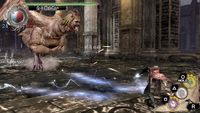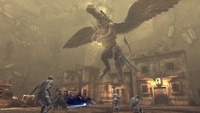|
|
 |
Soul
Sacrifice - Staff Review |
 |
Sacrificed Potential
by
Michael "Wheels" Apps
|
|
|
 |
PLATFORM
|
Vita
|
BATTLE
SYSTEM
|

|
INTERACTION
|

|
ORIGINALITY
|

|
STORY
|

|
MUSIC
& SOUND
|

|
VISUALS
|

|
CHALLENGE
|
Hard |
COMPLETION TIME
|
Less Than
20 Hours
|
|
OVERALL

|
+
Intriguing story and lore.
+
Fun fast paced battles.
+
Great audio/visual
presentation.
-
Disconnect between the story
and gameplay.
-
Lack of variety in enemies
and spells.
-
No real hook to keep
multiplayer engaging.
|
Click
here for scoring
definitions
|
|
|
Looking to breathe some life into
the slow sales of the Vita, Keiji Inafune's Soul
Sacrifice aims at filling the void left by Monster
Hunter moving to Nintendo's portables. Not
strictly a Monster Hunter clone, Soul
Sacrifice tries to go its own way while still
providing addicting combat against challenging
monsters. Unfortunately, some of the ways that it
deviates from the formula set by Capcom's series
actually serve to harm the game and its lasting
appeal. At least it does have a dark and interesting
tale to tell despite these gameplay issues.
Soul Sacrifice takes
place in a dark fantasy world where sorcerers are
constantly at battle with monsters, or rather, it
takes place in the grim apocalypse of this world.
The player takes the role of a prisoner of the mad
sorcerer Magusar. After a fellow prisoner fails to
fight the sorcerer with the help of a talking book,
that tome falls into the hands of the player. This
talking book serves as the interface for the game as
well as a commentator as the player experiences the
story through its pages. Within its pages is the
story of a nameless sorcerer who served as Magusar's
partner up until the world reached its current
state. The story focuses primarily on the nameless
sorcerer and Magusar and does a fantastic job of
building their relationship. The two struggle with
the life of hunting and sacrificing monsters and
fellow sorcerers, as the sacrificed souls are
absorbed into their arms, and their memories often
seep into their own. This memory issue pervades much
of the narrative, and provides many great twists and
turns.
Players can also experience
several side adventures telling the tale of other
sorcerers. These tales aren't quite as interesting
as the main story, but still serve as an interesting
diversion.The book also has a number of lore entries
that help give depth to creatures and locations in
the world. Many of these entries are even told as
short stories which make them far more interesting
to read. It will make players want to explore Soul
Sacrifice's diverse world, which unfortunately
they cannot do. The game is expertly localized all
around with some great voice performances so players
will find little reason not to dig into the game's
dark tales.
The only real issue with the story is
the way it can feel completely detached from the
game's gameplay. Gameplay in Soul Sacrifice
boils down to arena battles against either large
numbers of small monsters, or one or two larger
ones. The game does a great job providing lore for
the monsters and locations, but apart from that it
can feel very disconnected from the tale. Often
times the battle for a story chapter will feature
monsters or a location not even mentioned by the
characters during the last sequence. Further
confusing things, there will sometimes be fellow
sorcerers to save or sacrifice in a battle which
have no mention in the sequences before or after
that battle. Since the story is told solely through
story book style sequences and never in the engine
used by battles, there's really nothing to even
distinguish story missions from non-story missions
except for the occasional story related dialog at
the start of a battle. Despite the obvious attempt
to distance itself from Monster Hunter, the
game could have used some kind of home base to
explore and talk to other sorcerers. The book
interface is an interesting idea, but distances the
player too much from the game world.
 One of
the first... and last
enemies in the game,
highlighting the lack of enemy
variety. One of
the first... and last
enemies in the game,
highlighting the lack of enemy
variety. |
|
Thankfully, despite these issues the
battles themselves can be quite engaging. The player
creates a custom avatar to relive the events of the
nameless sorcerer's life, and they can take a
selection of six spells into combat. Instead of
using a magic point system of some kind, each spell
has a set number of uses. These charges can be
refilled by sacrificing defeated enemies, or by
using a few one off recharge points that appear in
most areas. Even with these recharge options
available, careful management and uses of spells is
vital. The spells come in a variety of forms, such
as swords and other melee weapons, mortar-like
ranged spells, and defensive spells such as shields
and armor. At first this variety seems extensive,
but in fact many of the spells are just alternate
versions with different elemental affinities.
The plague of palette-swaps also
extends to the monsters the player battles in the
game. The number of different monster types is in
fact relatively small, with monsters often being
reused with increased attack and defense or swapped
elemental affinity. At least the monsters that are
available are quite engaging. Attack patterns are
often aggressive and difficult to deal with, and
discovering elemental weaknesses is not always
obvious. Large monsters feature a number of cursed
parts that can be attacked, which decreases the
power of the monster when destroyed.
When defeating monsters, players
have the option to save or sacrifice them, which
serves as Soul Sacrifice's leveling system.
Sacrificing monsters refills spell charges in a
battle as previously mentioned, but also adds
experience toward leveling up the player's attack
stat. Saving a monster restores some hit points and
add experience towards leveling up the player's hit
points and defense stat. This ensures that some
balance of the two will be present, though there are
incentives for increasing one a certain degree over
the other.
 Teamwork
is essential in multiplayer. Teamwork
is essential in multiplayer.
|
|
Furthering the theme of
sacrifice, players can equip one black rite that
lets them sacrifice something, such as defense for a
powerful attack. To restore this sacrificed element,
players get a number of lacrima points for
completing missions which can be used in this
regard. These points can also be used to restore
spells that are used up in a battle, though if
players are careful not to overuse them they are
restored between battles. Players can also choose to
sacrifice or save fallen AI or multiplayer allies.
Saving them simply brings them back to life while
sacrificing them unleashes a powerful attack, but
then that companion is dead for the duration of the
battle, able to do nothing except wander around as a
ghost and provide slight buffs to allies or debuffs
to enemies. A dying player can give their indication
as to whether they would like to be saved or not,
but even AI companions are under no obligation to
follow this request. Dark aligned AI commands will
have no qualms about sacrificing a player early on
in a battle regardless of his/her requests.
Players can equip a number of
different sigils to enhance attack and defense
stats, some of which are enhanced by having a
greater number of dark or divine levels. More sigils
to equip can be unlocked by acquiring more materials
from monsters by sacrificing or saving them.
Unfortunately, these sigils never feel like they
have much of a tangible impact on combat. This robs
the game of a lot of its replayability because
hunting for materials for new sigils never feels
important. There's not much of a tangible reason to
play the game's many non-story battles outside of
getting some new spells and grinding a few levels.
The battles can still provide plenty of
entertainment, especially when played in multiplayer
with friends, but it doesn't have the same lasting
appeal as the Monster Hunter series whose
appeal it tries to copy.
Other than the previously
mentioned lack of variety with monsters, there is
little to complain about in terms of graphics. The
arenas are rich with detail and background scenery,
which help to emphasize the game's dark world. Enemy
attacks and spells look great and show the power of
this world's magic. Sounds match up effectively with
these attacks, making each spell sound appropriate
to both its type and its element. Music helps
provide an epic feel to the game's battles, with a
number of memorable sweeping scores to help add
drama to battle. Soft orchestral scores are used
during the more somber sequences, but these end up
being forgettable and repetitive in sharp contrast
to battle. Overall, the audio/video package
makes effective use of the Vita's power.
Soul Sacrifice is a noble
first effort from Inafune and company to fill the Monster
Hunter void, but it can't quite match the
addictive depth of that series. The combat is fun
and challenging, but a lack of variety hurts it a
great deal. The story is engrossing and paints a
fascinating world, but often feels disconnected from
the actual gameplay. The game doesn't provide much
incentive to grind through lots of battles, but a
sharp difficulty curve in single player necessitates
just this to level up. This is a game of
contradictions, about sacrificing and saving, but
unfortunately this extends to the very core of the
game itself. Every great element of the game is
hampered in some way, as if the developers had to
sacrifice some potential to make the game happen. Soul
Sacrifice is a fine game, but it could have
been brilliant.
Review
Archives
|
|
|









